How To Repair Frost Free Yard Hydrant
Yard Hydrants are Frost-free and are great for getting water to remote locations that need it year round. In this web log, we are going to go over some of the common aligning and repair procedures.
If yous take any further questions about these instructions, contact our Technical Support Team.
The Common problems / adjustments that we volition address are:
- Yard Hydrant will not Shut-off Completely
- Yard Hydrant is Leaking at the Stem Packing
- Replacement of Yard Hydrant Caput
- Replacement of Chiliad Hydrant Plunger
Thou Hydrant will not Close-off Completely
Over fourth dimension the rubber plunger will article of clothing and it may exist necessary to adjust the hydrant. While it is rare that a new hydrant will leak, there is from fourth dimension to time a case where the hydrant will lose it'due south manufactory setting. At that place is not need to panic the hydrant is non lacking!
If the hydrant will non shut off completely, there are a few simple steps to adjust the hydrant linkage to it's proper closing position.
Step one


The rubber plunger (Due north) in the bottom of the hydrant can be lowered by raising the point of contact of the square caput set screw (H) on the Southward.S. operating rod (D)
Using a five/xvi" wrench, loosen the square head bolt so the handle tin can exist moved up and downward freely without moving the operating rod.
Step 2 & 3
Lift the handle (B) to the fully open position. 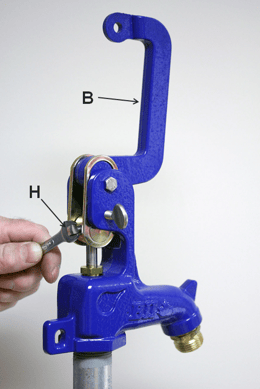
With the handle (B) up in the fully open position, tighten the foursquare head commodities (H)
Step 4
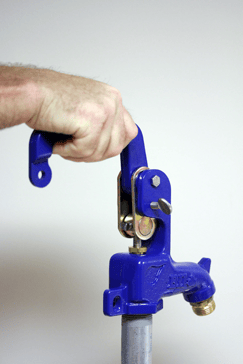 Apply endmost pressure level on the handle - this will forcefulness the operating rod to assembly / plunger (N) down-wards until it makes contact with the valve seat in the valve body (O). Do non strength the handle downward -when the handle stops moving yous take positioned the plunger against the valve body seat. Stop!
Apply endmost pressure level on the handle - this will forcefulness the operating rod to assembly / plunger (N) down-wards until it makes contact with the valve seat in the valve body (O). Do non strength the handle downward -when the handle stops moving yous take positioned the plunger against the valve body seat. Stop!
Stride v
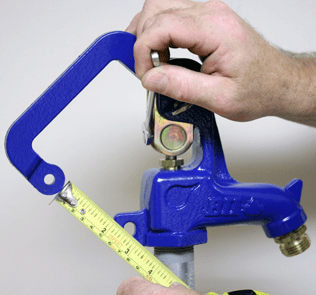 5a - Set the closing pressure – To practise so y'all must loosen the square head bolt again, allowing the handle to be moved upwardly and down freely without moving the operating rod. – DO Not MOVE THE OPERATING ROD FROM POSITION IN Stride #4
5a - Set the closing pressure – To practise so y'all must loosen the square head bolt again, allowing the handle to be moved upwardly and down freely without moving the operating rod. – DO Not MOVE THE OPERATING ROD FROM POSITION IN Stride #4
5b- Position the handle so that at that place is approx. 2" between the handle and the locking tab on the head casting.
Then using a 5/sixteen" wrench, tighten the square caput bolt and so the handle will force the operating rod downward and employ force per unit area to close the handle.
Yard Hydrant is Leaking at the Stem Packing
 The brass packing nut (F) has been factory adjusted. If leakage does occur it can be easily stopped with a slight adjustment to further compress the double O-Band seal packing.
The brass packing nut (F) has been factory adjusted. If leakage does occur it can be easily stopped with a slight adjustment to further compress the double O-Band seal packing.
Footstep #SPA-one
Simply tighten the contumely packing nut (F) by turning information technology clockwise in very minor increments until the leakage stops using a ¾" open cease wrench.
Caution: DO NOT over tighten packing nut. Excessive compression will outcome in accelerated wear and or peradventure damage to the O-Rings.
Replacement of Yard Hydrant Head
 Sometimes, the hydrant caput (A) must exist removed due to damages or to replace the plunger (Due north).
Sometimes, the hydrant caput (A) must exist removed due to damages or to replace the plunger (Due north).
Practice non place a pipe wrench on the galvanized stand pipe (Q), it volition cause harm to the mill blanket. To preclude the galvanized stand pipe (Q) from turning, use a strap wrench; this should also be followed if tightening the valve body (O).
Information technology is VERY of import that the first two steps be followed carefully to avoid the potential for serious complications.
Failure to practice and then could result in the plunger un-threading from the connecting rod which could be difficult to re-assemble, possibly resulting in the need to dig upwardly the hydrant unnecessarily.
Step 1
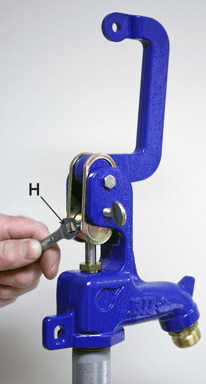 Loosen the 5/sixteen"-eighteen UNC x ¾" 18.8 Stainless Steel Gear up Screw (H) to allow the 3/eight" stainless steel operation rod (D) to turn freely in the zinc plated pivot connector (Thousand)
Loosen the 5/sixteen"-eighteen UNC x ¾" 18.8 Stainless Steel Gear up Screw (H) to allow the 3/eight" stainless steel operation rod (D) to turn freely in the zinc plated pivot connector (Thousand)
Stride 2
 Loosen the ¾" brass packing nut (F) until it is non putting any pressure on the O-Ring seals (E) information technology is better to turn it out completely than to have pressure on the O-Rings which could consequence in the operating rod turning with the head casting (A) loosening the packing nut allows the 3/viii" stainless steel operation rod (D) to turn freely from the head casting (A)
Loosen the ¾" brass packing nut (F) until it is non putting any pressure on the O-Ring seals (E) information technology is better to turn it out completely than to have pressure on the O-Rings which could consequence in the operating rod turning with the head casting (A) loosening the packing nut allows the 3/viii" stainless steel operation rod (D) to turn freely from the head casting (A)
Step three
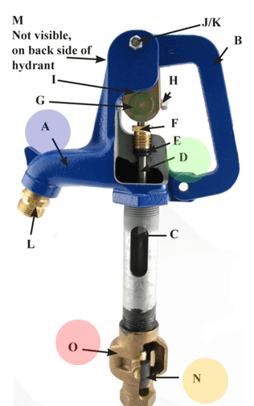 Remove the head casting (assembly) (A) by turning the head casting counter clockwise (lefty loosey) using a pipe wrench.
Remove the head casting (assembly) (A) by turning the head casting counter clockwise (lefty loosey) using a pipe wrench.
WARNING!
Brand sure to monitor the 3/eight" stainless steel operating rod (D) while turning the head casting off the pipe thread. The rod MUST Not plow! If the rod turns it could unthread the connecting rod from the plunger (Northward) due to the snug fit in the valve body (O)
TIP! – place a cloth or soft leather or rubber sheet between the pipage wrench jaws and the caput casting to forbid harm to the corrosion resistant protective paint coating.
Step 4
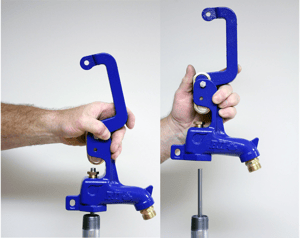
When the head casting (A) is gratuitous from the Galvanized stand pipage (Q) approx. 3 – 4 full revolutions, pull the head casting straight up.
At this signal, you would exist able to fix any damage inside the hydrant or fully replace the caput.
Step 5
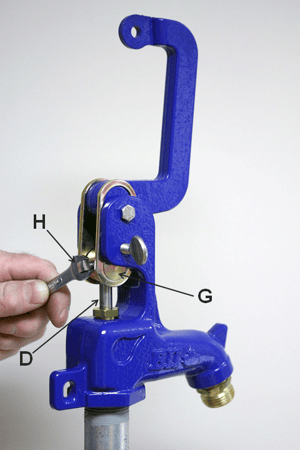 Brand sure the 5/16"-18 UNC ten ¾" eighteen.eight Stainless Steel Set up Spiral (H) is turned out to permit the three/8" stainless steel operating rod (D) to slide freely thru the zinc plated pin connector (G)
Brand sure the 5/16"-18 UNC ten ¾" eighteen.eight Stainless Steel Set up Spiral (H) is turned out to permit the three/8" stainless steel operating rod (D) to slide freely thru the zinc plated pin connector (G)
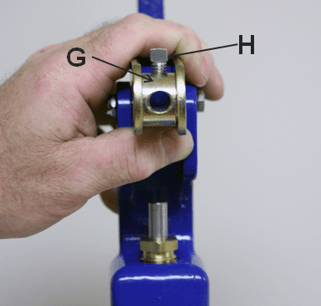
Footstep 6
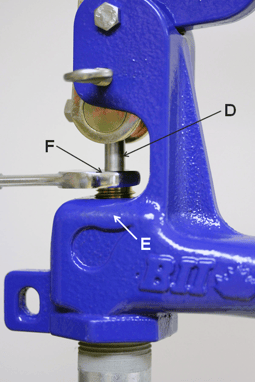 Make sure the ¾" contumely packing nut (F) is loose and is non putting whatsoever pressure level on the O-ring seals (E) to allow the three/8" stainless steel functioning rod (D) to slide freely thru the O-rings (E)
Make sure the ¾" contumely packing nut (F) is loose and is non putting whatsoever pressure level on the O-ring seals (E) to allow the three/8" stainless steel functioning rod (D) to slide freely thru the O-rings (E)

Pace 7
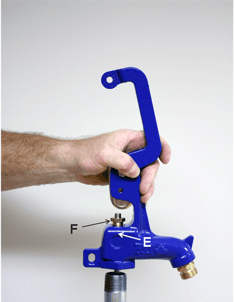 Lower the caput casting downward so the 3/8" stainless steel operation rod (D) slides thru the O-ring seals (East) and the ¾" brass packing nut (F) and thru zinc plated pin connector (G)
Lower the caput casting downward so the 3/8" stainless steel operation rod (D) slides thru the O-ring seals (East) and the ¾" brass packing nut (F) and thru zinc plated pin connector (G)
Step viii
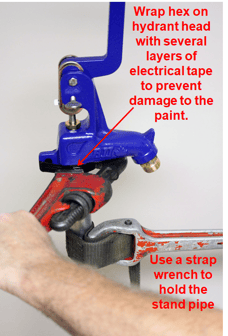 When the caput casting (A) touching the Galvanized stand up pipe (Q) apply P.T.F.E. (aka: Teflon) tape or pipe thread sealing compound to the pipage threads, turn the caput casting clockwise engaging the threads making sure that they start freely by hand. Tighten using a piping wrench (righty tightly) approx. 3 – 4 full revolutions until head casting is secure. NO Non OVERTIGHTEN!
When the caput casting (A) touching the Galvanized stand up pipe (Q) apply P.T.F.E. (aka: Teflon) tape or pipe thread sealing compound to the pipage threads, turn the caput casting clockwise engaging the threads making sure that they start freely by hand. Tighten using a piping wrench (righty tightly) approx. 3 – 4 full revolutions until head casting is secure. NO Non OVERTIGHTEN!
Step 9
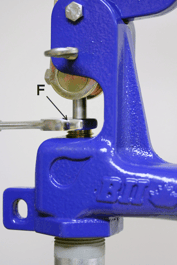 Tighten the ¾" brass packing nut (F) until it is putting pressure on the O-ring seals (E) ofttimes paw tight is plenty Notation: it takes very little compression to brand a positive seal.
Tighten the ¾" brass packing nut (F) until it is putting pressure on the O-ring seals (E) ofttimes paw tight is plenty Notation: it takes very little compression to brand a positive seal.
Alarm!
Over tightening of the packing nut can cause premature wearable and damage to the O-ring seals. Information technology is all-time to manus tighten at first and tighten farther in small-scale increments every bit required until whatsoever leakage is stopped when the water pressure level is turned back on.
Stride 10
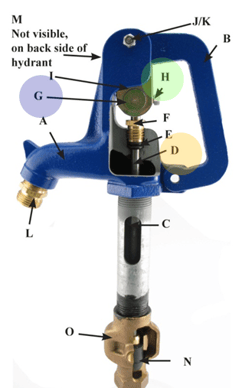 Adjust the hydrant setting following steps covered in "How do I suit the hydrant if information technology has a baste or will non shut off completely?"
Adjust the hydrant setting following steps covered in "How do I suit the hydrant if information technology has a baste or will non shut off completely?"
When adjustment is complete tighten the 5/16"-18 UNC x ¾" eighteen.viii Stainless Steel Prepare Screw (H) securely to the 3/viii" stainless steel operation rod (D) in the zinc plated pin connector (G) to prevent slippage of the rod in the pin connector which would result in the loss of the hydrant setting. NOTE: The specially cupped set screw (H) grips very well on the rod so with moderate tightening of the set screw should exist sufficient.
Practise not leave hose fastened to hose bib in freezing temperatures as information technology may forbid proper drainage of the shut-off valve.
If hose is attached to the hose bib of the hydrant when the hydrant is shut-off, dorsum siphoning can occur if terminate of hose is left in container of liquid. The end of the hose must be left open to the air so hydrant can drain dorsum. A back menstruum forbid should exist installed if a hose is left on during the warm summer season.
Replacing the M Hydrant Plunger
Step 1
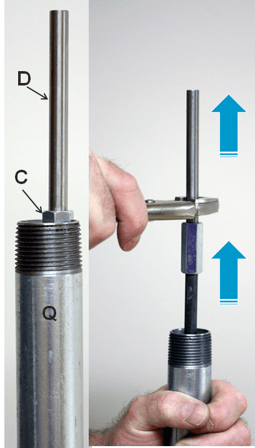 With the head casting removed the hydrant head casting removed, the S.South. operating rod (D) will be protruding out of the galvanized stand pipe (Q) approx. 3-one/2"
With the head casting removed the hydrant head casting removed, the S.South. operating rod (D) will be protruding out of the galvanized stand pipe (Q) approx. 3-one/2"
Pull the South.S. operating rod (D), coupling [C] connection rod [R] and plunger assembly straight upwardly.
NEVER TWIST COUNTER CLOCKWISE, THIS COULD CAUSE THE PLUNGER TO UNTHREAD FROM THE ROD.
Stride two
 Grip the steel connection rod "R" with a vice grips just to a higher place the plunger (North), with a second vice grip deeply grip the brass insert on the plunger assembly (stainless steel on newer models), and so turn the plunger counter clockwise approx. vii-one/two to eight turns (nigh ½" thread) to unthread the plunger from the rod.
Grip the steel connection rod "R" with a vice grips just to a higher place the plunger (North), with a second vice grip deeply grip the brass insert on the plunger assembly (stainless steel on newer models), and so turn the plunger counter clockwise approx. vii-one/two to eight turns (nigh ½" thread) to unthread the plunger from the rod.
Step 3
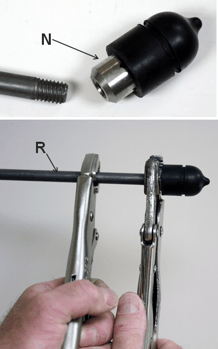 Proceed the grip the rod "R" with a vice grips just above the plunger, with the 2nd vice grip the stainless steel insert on the new plunger (N) securely and turn the plunger clockwise to thread it onto the rod.
Proceed the grip the rod "R" with a vice grips just above the plunger, with the 2nd vice grip the stainless steel insert on the new plunger (N) securely and turn the plunger clockwise to thread it onto the rod.
Tighten securely.
Step 4
 Remove both vice grips, and advisedly lower the entire rod and plunger associates (Southward.S. operating rod (D), coupling ©, connecting rod ® and plunger assembly (North)) direct down in the stand up pipe until the plunger is pressed into the valve body (O) confronting the valve seat.
Remove both vice grips, and advisedly lower the entire rod and plunger associates (Southward.S. operating rod (D), coupling ©, connecting rod ® and plunger assembly (North)) direct down in the stand up pipe until the plunger is pressed into the valve body (O) confronting the valve seat.
NEVER TWIST THE Assembly COUNTER CLOCKWISE, THIS COULD CAUSE THE PLUNGER TO UNTHREAD FROM THE ROD!
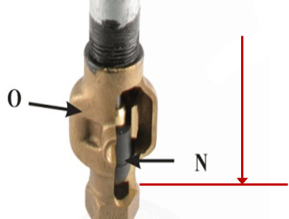
Later this is complete, refer back to the G Hydrant Head installation instructions. This shows how to install the existing or a new caput.
Accept further questions about this subject?

Head over to Boshart's Knowledge Base: technical product information, guidelines, and more.
Source: https://blog.boshart.com/how-to-adjust-and-repair-a-boshart-yard-hydrant

0 Response to "How To Repair Frost Free Yard Hydrant"
Post a Comment